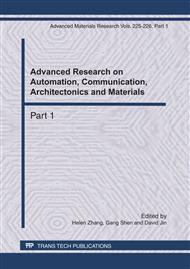p.1084
p.1088
p.1092
p.1096
p.1100
p.1105
p.1109
p.1115
p.1120
Harmony Search Algorithm and its Application to Product Module Identification
Abstract:
Point to product module identification, a new optimization method is proposed in this paper. This approach uses the harmony search (HS) algorithm with the synthesis design structure matrix (DSM). The synthesis DSM thinks a series of property correlations facing the product lifecycle, such as function, geometer, physics, assistant and so on. An optimization function for module identification, based on the axiomatic design theory, is established. This optimization approach, which used HS algorithm, is tested several times and compared with other classical algorithms, such as simulated annealing algorithm (SAA) and genetic algorithm (GA). The result demonstrates the feasibility of the proposed approaches.
Info:
Periodical:
Pages:
1100-1104
Citation:
Online since:
April 2011
Price:
Сopyright:
© 2011 Trans Tech Publications Ltd. All Rights Reserved
Share:
Citation:


